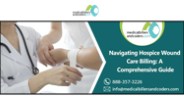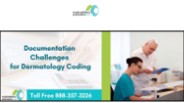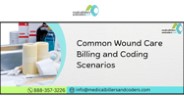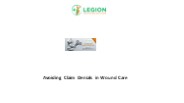Wound Documentation PowerPoint PPT Presentations
All Time
Recommended
Ensure accurate wound care documentation for optimal patient care and higher reimbursement rates. Learn how comprehensive documentation practices can impact outcomes.
| PowerPoint PPT presentation | free to download
With essential wound care documentation requirements discussed in this article, you can navigate complex landscape of wound care documentation effectively.
| PowerPoint PPT presentation | free to download
To share common wound care documentation errors we referred Medicare claim data where two major HCPCS codes A6197 and A6199 are prominently used.
| PowerPoint PPT presentation | free to download
In this article, we shared medical necessity documentation examples to help healthcare professionals create comprehensive and accurate documentation.
| PowerPoint PPT presentation | free to download
Wound documentation helps healthcare providers to track progress in wound healing & utilize important therapeutic options. https://goo.gl/96aq3t
| PowerPoint PPT presentation | free to download
"Copy Link : gooread.fileunlimited.club/pwjul24/0826195024 Fast Facts for Wound Care Nursing, Second Edition: Practical Wound Management Simplifies the wound care process with clear, succinct information and the newest treatment protocols Freshly updated with the newest evidence-based techniques and protocols, this practical clinical resource distills the fundamentals of wound care for novice nurses and nurses new to wound care. This guide walks through the common, complex and atypical wounds nurses see and includes abundant full-color images. Chapters have been thoroughly revised and now contain critical updates in technological advances in wound care, dramatic changes in documentation and new Medicare and reimbursement guidelines.Fast Facts for Wound Care Nursing, Second Edition is an invaluable companion for the day-to-day care of wound patients, reinforcing knowledge needed in acute care, critical care, long-term care, homec"
| PowerPoint PPT presentation | free to download
Title: The Principles of Wound Healing Author: TMC Last modified by: Tulane Created Date: 10/8/2001 3:18:05 PM Document presentation format: On-screen Show (4:3)
| PowerPoint PPT presentation | free to view
Accurate description is important. Medico-legal implications ... Squirrels, hampsters. Delayed Presentations. In general do not suture wounds after 6 hours ...
| PowerPoint PPT presentation | free to view
... (Tecnis 1-piece IOL model ZCB00, AMO) ... but is at least less than 2.8 mm based on one study.7,8 As technological advances allow further reductions in wound ...
| PowerPoint PPT presentation | free to download
Agentcities Information Day 3. Barcelona, February 6-8, 2003. Hans Kyhlb ck ... HEDVIG, a first prototype developed. in autumn 2001. February 2003 ...
| PowerPoint PPT presentation | free to view
Wound Assessment & Documentation Anita Hedzik CDN Ward 5B/C Princess Margaret Hospital Wound Assessment Holistic Approach General assessment Determine Type of Wound ...
| PowerPoint PPT presentation | free to view
Wounds Nursing Fundamentals Chapter 28 Wound A break in the continuity of soft parts of body structures caused by violence or trauma to tissues Damaged skin or soft ...
| PowerPoint PPT presentation | free to view
Wound care billing can be a complex and challenging process due to several factors including, coding complexity, documentation requirements, reimbursement limitations, billing multiple payers, and risk of fraud & abuse billing.
| PowerPoint PPT presentation | free to download
Maximize Medicare coverage for wound care and supplies to optimize revenue and deliver high-quality care to patients with wounds.
| PowerPoint PPT presentation | free to download
Discover how Medicare can provide coverage for wound care. Find out how Medicare Part B can help with supplies and treatments
| PowerPoint PPT presentation | free to download
In this article, we tried to answer intricacies of hospice wound care billing by sharing billing and coding guidelines along with documentation requirements.
| PowerPoint PPT presentation | free to download
Title: GUNSHOT WOUNDS Author: mcurtis Last modified by: osheils Created Date: 10/16/2005 7:55:59 AM Document presentation format: On-screen Show Company
| PowerPoint PPT presentation | free to view
Wound care providers face unique challenges when it comes to medical billing. Proper coding and documentation are crucial to ensure that claims are processed accurately and efficiently. Failure to comply with billing regulations can result in denied claims, delayed payments, and potential legal issues. This is where a thorough understanding of wound care billing comes into play.
| PowerPoint PPT presentation | free to download
Improve your wound care medical coding with accurate documentation and coding practices. Learn about the challenges in wound care coding.
| PowerPoint PPT presentation | free to download
Wound dressing Prepared by Miss Aisha Al-hofaian Supervised by Dr.Gehan Purpose 1- To promote wound ... Support and hold the drain erect while cleaning around ...
| PowerPoint PPT presentation | free to download
Struggling to secure timely payments in wound care? Discover Q4 AR best practices that can help minimize claim denials and maximize wound care revenue.
| PowerPoint PPT presentation | free to download
Master the complexities of dermatology billing and coding. Discover tips and best practices to avoid errors and optimize reimbursement.
| PowerPoint PPT presentation | free to download
Maximize your cash flow in wound care with accurate billing and coding practices. Avoid claim rejections and revenue losses.
| PowerPoint PPT presentation | free to download
Title: PowerPoint Presentation Last modified by: ekennedy Document presentation format: On-screen Show (4:3) Company: Kim Koetz User Other titles
| PowerPoint PPT presentation | free to view
Title: GUNSHOT WOUNDS Author: mcurtis Last modified by: osheils Created Date: 10/16/2005 7:55:59 AM Document presentation format: On-screen Show Company
| PowerPoint PPT presentation | free to view
The problem is that not all forms of wound care are paid for by insurance, and those that are reimbursed require a number of administrative tasks like correct documentation, precise detailing, and accurate coding. Before submitting a claim, clinicians at medical settings must determine whether the wound treatment complies with the requirements for medical necessity and whether the patient’s insurance coverage will pay for it.
| PowerPoint PPT presentation | free to download
Title: WOUND HEALING Author: Mirkia Last modified by: EMU-DOCTORS Created Date: 11/7/2006 10:03:20 PM Document presentation format: On-screen Show (4:3)
| PowerPoint PPT presentation | free to view
Wound care billing and coding errors can lead to revenue loss. Here are some common factors to consider to streamline billing scenarios.
| PowerPoint PPT presentation | free to download
Are wound care AR challenges disrupting your practice? Discover essential strategies to optimize accounts receivable and boost your financial health.
| PowerPoint PPT presentation | free to download
Poor wound care billing can adversely impact your practice’s financial health. Here are the best practices for wound care billing and coding.
| PowerPoint PPT presentation | free to download
Gunshot Wounds Michael Sirkin, MD Chief, Orthopaedic Trauma Service Assistant Professor, New Jersey Medical School North Jersey Orthopaedic Institute
| PowerPoint PPT presentation | free to view
Are billing issues hindering your wound care revenue? Discover how MBC's proven strategies can optimize your billing and maximize your earnings.
| PowerPoint PPT presentation | free to download
Learn effective strategies to maximize reimbursement for high-value wound care cases and avoid financial losses in your practice.
| PowerPoint PPT presentation | free to download
At SHWCConsultants, we are specialist at providing wound care consultants, hyperbaric consulting and facility management to hospitals and clinics.
| PowerPoint PPT presentation | free to download
Struggling with complex wound care billing? Discover best strategies to streamline wound care diagnosis and treatment billing and boost revenue.
| PowerPoint PPT presentation | free to download
Title: Maggots in Wound Care Author: Mary Jones Last modified by: Tony Created Date: 10/24/2005 5:01:20 PM Document presentation format: On-screen Show
| PowerPoint PPT presentation | free to download
Struggling to manage wound care claim rejections and recover legacy AR? Here’s how you can reduce claim denials and optimize the billing process.
| PowerPoint PPT presentation | free to download
Rejected claims in wound care billing can greatly impact your revenue. Here is a detailed guide for avoiding rejection of wound care claims.
| PowerPoint PPT presentation | free to download
Spiral wound gaskets are used in various industries, including oil and gas, petrochemical, power generation, chemical processing, and refining.
| PowerPoint PPT presentation | free to download
Optimize Wound Care reimbursement! Perfect Medical Coding for quick claims and fair pay. Partner with MBC for expert Billing services.
| PowerPoint PPT presentation | free to download
We explored, does Medicare cover wound care and what healthcare providers need to know to ensure their patients receive the best care possible.
| PowerPoint PPT presentation | free to download
Not only is wound coding and documentation is a daunting task, but also attracts intense inspection from auditors, with severe financial penalties for mistakes. And it’s only gotten more challenging with the new ICD-10 changes.
| PowerPoint PPT presentation | free to download
Wound care Susie Pease Return to Practice (Nursing) School of Healthcare Studies The University of Leeds Assessment Assess individual wound environment Plan Implement ...
| PowerPoint PPT presentation | free to view
Digital Wound Measurement Devices are advanced medical devices that assist healthcare professionals in accurately measuring the dimensions of chronic wounds, such as ulcers and burns. These devices use digital imaging and computer-based algorithms to provide precise measurements, which help in effective wound management and treatment decisions.
| PowerPoint PPT presentation | free to download
Struggling with maximizing collections in high-volume wound care? Discover how to enhance revenue cycle management and optimize collections for financial stability.
| PowerPoint PPT presentation | free to download
Explore the complexities of revenue challenges in wound care, from billing intricacies to revenue cycle management. Learn strategies to overcome obstacles and optimize your wound care billing practices.
| PowerPoint PPT presentation | free to download
Losing revenue on wound care reimbursements? Discover strategies to maximize your reimbursements and avoid costly billing errors.
| PowerPoint PPT presentation | free to download
Wound care plays a pivotal role in managing and treating a wide spectrum of injuries, from acute wounds to chronic ulcers. As with any medical procedure, accurate and compliant billing is crucial for ensuring financial reimbursement and adherence to regulatory standards. However, the complexities of wound care coding often lead to billing errors, potentially resulting in claim denials, financial losses, and even legal repercussions.
| PowerPoint PPT presentation | free to download
Claim denials in wound care practice can be stressful. Discover how precise coding can avoid denials in wound care billing and boost revenue.
| PowerPoint PPT presentation | free to download
It is the professional coders' mandate to understand the physicians' documentation, to appropriate bills and code for wound care billing services, and to lead the path for lesser denials and eventually soaring cash flows.
| PowerPoint PPT presentation | free to download
Preparing Physicians for ICD-10 Date: _____ Subject: Unanswered Post Query 3rd and Final Attempt Dr._____ Please, if ...
| PowerPoint PPT presentation | free to download
With a good EMR system, wound clinics can benefit from standard documentation, reduced errors, and labor and time savings.
| PowerPoint PPT presentation | free to download
Title: WOUNDS AND INJURIES Author: IT Division Last modified by: osheils Created Date: 4/10/2003 7:55:29 PM Document presentation format: On-screen Show
| PowerPoint PPT presentation | free to view
Accurate medical billing is crucial in wound care. Learn why properly submitting claims is essential for reimbursement and compliance with regulations.
| PowerPoint PPT presentation | free to download
Financial markers for successful wound care billing can be used to identify areas for improvement, such as increasing collections, reducing denials, etc.
| PowerPoint PPT presentation | free to download
In wound care, claim denials occur when a healthcare provider’s claim for payment is rejected by the payer, which may be a government program, insurance company, or other third-party payer. Claim denials can happen for various reasons, such as coding errors, missing or incorrect information, lack of medical necessity, and policy or regulatory issues.
| PowerPoint PPT presentation | free to download
























































